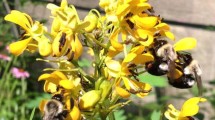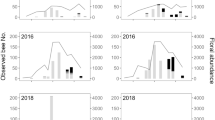Summary
Bumblebee foraging behavior was observed on two plant species with similar floral and inflorescence structures. One species produces nectar while the other does not. Bees, upon visiting nectar producing flowers tend to empty them of nectar and by frequently moving between close neighbors, create a patchily distributed resource base. Bees maximize their foraging efficiency in such an environment by using an area-restricted searching behavior and flying distances inversely correlated with the quality of reward received. Pollen collecting bumblebees do not create a patchy environment and maximize their foraging efficiency by more consistently moving shorter distances. Pollen collecting bumblebees are significantly more likely to revisit flowers and to visit more flowers per inflorescence than are nectar gathering bumblebees. These differences in foraging behavior increase the neighborhood size for nectar producing species and make it increasingly unlikely that random drift will be a dominant mode of evolution in populations of these species.
Similar content being viewed by others
References
Beattie AJ, Culver DC (1979) Neighborhood size in Viola. Evolution 33:1226–1229
Endler JA (1977) Geographic Variation, Speciation and Clines. Princeton University Press, Princeton
Kerster HW, Levin DA (1968) Neighborhood size in Lithospermum caroliniense. Genetics 60:577–587
Levin DA, Kerster HW (1969a) Density-dependent gene dispersal in Liatris. Amer Natur 103:61–74
Levin DA, Kerster HW (1969b) The dependence of bee-mediated pollen dispersal on plant density. Evolution 23:560–571
Ollason JG (1980) Learning to forage — optimally? Theoret Pop Biol 18:44–56
Pleasants JM (1977) Competition in plant-pollinator systems: An analysis of meadow communities in the Colorado Rocky Mountains. Ph D Thesis, University of California, Los Angeles
Pleasants JM (1980) Competition for bumblebee pollinators in Rocky Mountain plant communities. Ecology 61:1446–1459
Pleasants JM, Zimmerman M (1979) Patchiness in the dispersion of nectar resources: evidence for hot and cold spots. Oecologia (Berl) 41:283–288
Poulsen MH (1973) The frequency and foraging behavior of honeybees and bumblebees on field beans in Denmark. J Apicult Res 12:75–80
Pyke GH (1978) Optimal foraging: movement patterns of bumblebees between inflorescences. Theoret Pop Biol 13:72–98
Pyke GH (1979) Optimal foraging in bumblebees: rules of movement between flowers within inflorescences. Anim Behav 27:1167–1181
Pyke GH (1981) Optimal foraging in nectar-feeding animals and coevolution with their plants. In: AC Kamil, Sargent TD (eds), Foraging Behavior. Garland Press
Schaal BA (1980) Measurement of gene flow in Lupinus texensis. Nature 284:450–451
Schaal BA, Leverich WJ (1980) Pollination and banner markings in Lupinus texensis (Leguminosae). Southwestern Natur 25:280–282
Schmitt J (1980) Pollinator foraging behavior and gene dispersal in Senecio (Compositae). Evolution 34:934–943
Thomson JD, Plowright RC (1980) Pollen carryover, nectar rewards, and pollinator behavior with special reference to Diervilla lonicera. Oecologia (Berl) 46:68–74
Wright S (1943) Isolation by distance. Genetics 28:114–138
Wright S (1946) Isolation by distance under diverse systems of mating. Genetics 31:39–59
Wright S (1969) Evolution and the Genetics of Populations Vol II The Theory of Gene Frequencies. University of Chicago Press, Chicago
Zimmerman M (1979a) An analysis of the reproductive strategies of Polemonium in Colorado. Ph D Thesis, Washington University, St. Louis
Zimmerman M (1979b) Optimal foraging: a case for random movement. Oecologia (Berl) 43:261–267
Zimmerman M (1981a) Nectar dispersion patterns in a population of Impatiens capensis. Virginia J Science: In Press
Zimmerman M (1981b) Optimal foraging, plant density and the marginal value theorem. Oecologia (Berl) 49:148–153
Zimmerman M (1981c) Patchiness in the dispersion of nectar resources: probable causes. Oecologia (Berl) 49:154–157
Author information
Authors and Affiliations
Rights and permissions
About this article
Cite this article
Zimmerman, M. The effect of nectar production on neighborhood size. Oecologia 52, 104–108 (1982). https://doi.org/10.1007/BF00349017
Received:
Issue Date:
DOI: https://doi.org/10.1007/BF00349017




